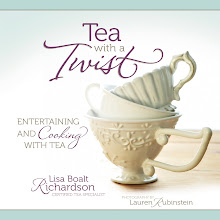While in Japan, Mr. Yamanashi was our host. He gave us some wonderful literature on the green teas of his country. I loved the simple explanation. It made it very clear to me and hope to you too!
Sencha- this tea is the most popular tea in Japan. It comes from the first and second harvests. The higher the grade, the more delicious the tea .
Fukamushicha - Also known as "deep-steamed Sencha." The leaves are steamed for a longer period of time than for regular Sencha. This results in a milder taste with reduced astringency.
Gyokuro - The tea plants are purposely shaded for three weeks prior to harvesting, which reduces the astringency and enhances the flavor. It is processed in the same fashion as Sencha.
 |
| Matcha |
 |
| Bancha |
Bancha - A tea with moderate astringency and flavor, harvested and processed between summer and autumn in the same manner as Sencha.
 |
| Genmaicha |
Genmaicha - A tea made from Sencha and Bancha combined with toasted brown rice (Genmai). It has a distinctive savory aroma and flavor.
Hojicha - Well-roasted Sencha or Bancha. It has a savory aroma and uniquely flavorful taste that lends itself well to drinking after meals, especially in the evening due to its lower caffeine content than some other teas.
 |
| Two different kinds of Hojicha |
Below is a new tea to me. Interesting that it is pan fired and not steamed as most Japanese teas are!
Kamairicha - Instead of steaming the new leaves, this tea is pan fired while being rolled. It lacks the characteristic of first-harvest aroma of Sencha, but has a light, refreshing taste.
I can't wait to show you all the places I visited. I hope this helps make the green teas of Japan a little clearer. Do you have a favorite Japanese tea?
Happy Sipping some Sencha, Lisa

















Dearest Lisa,
ReplyDeleteToo bad that the package of some delicious green tea has been tossed out so I cannot give you feedback on it. We always put the contents of different teas in our tea caddy and toss out the package. But your description is very informative and easily understandable too. Green tea has such great health qualities so people should discover it more.
Have a great weekend!
Mariette
This was wonderful! I know you loved your trip, the information was awesome!
ReplyDelete